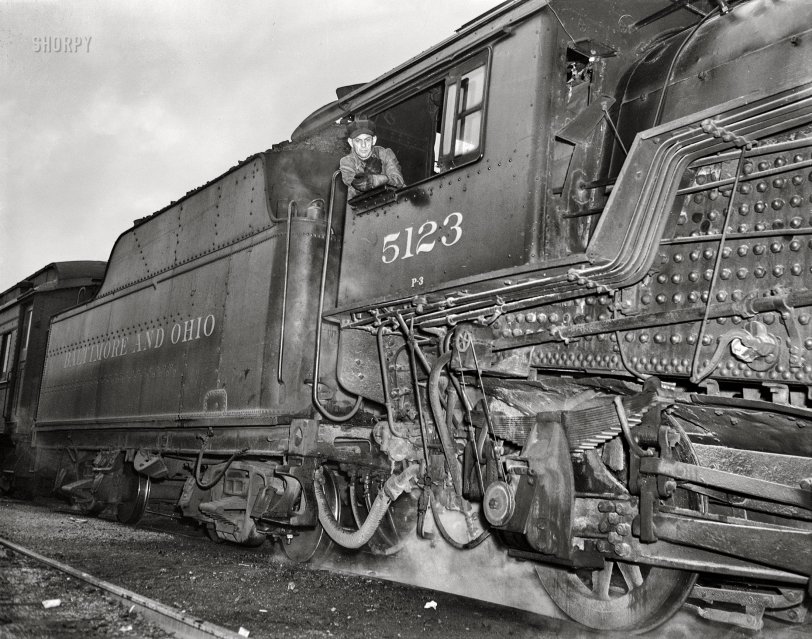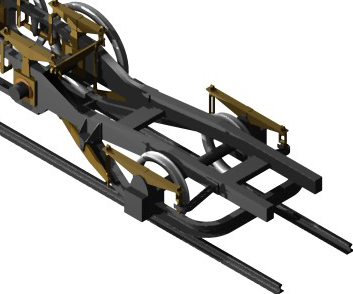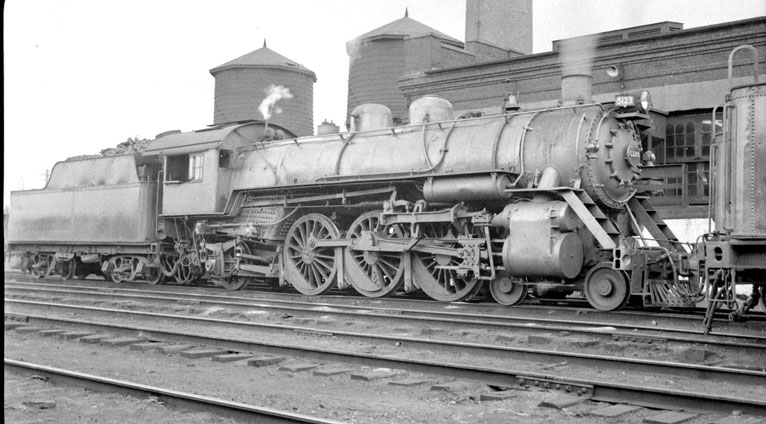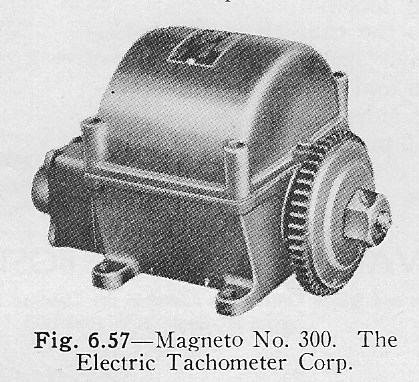


Framed or unframed, desk size to sofa size, printed by us in Arizona and Alabama since 2007. Explore now.
Shorpy is funded by you. Patreon contributors get an ad-free experience.
Learn more.

- Lofty addition
- In 1912
- Keenan Building
- Six years old
- Taken from the P.J. McArdle Roadway?
- It stood only 47 years
- Three track mind
- Incline to the right
- Reach for the sky, 1912 style
- No clean sweep
- Same Job Title, Same Face
- Sadly Lost
- Beautiful ...
- Where you get your kicks
- Aim High
- Pueblo Revival sisters
- Pueblo Neoclassicism
- Milk Man
- Regional dialect.
- Spielberg's inspiration
- Great Photo
- Loaf Story
- Do you still have the Rakes category?
- Could almost be a scene from the 1957 movie 'Hell Drivers'
- The Wages of Fear.
- Conspicuous by their absence
- Got Milk?
- All that aluminum
- No lefties
- Smoke 'em if you've got 'em
Print Emporium
B&O: 1942

September 1942. "Richwood, West Virginia. An engineer on the Baltimore and Ohio Railroad." 4x5 inch acetate negative by John Collier for the Farm Security Administration. View full size.
Been There, Done That
I've hand fired a steam locomotive of that size and type. Yeah, It's work, but one man can do it.
Fireman or firemen?
A engine that size is approaching, but doesn't exceed, the limits of what one good fireman can handle. Probably a bit over 4 tons per hour.
On a passenger engine, such as this one, he was also keeping the floor swept, monitoring the water level in the boiler, and watching track conditions and signals ahead, among other things.
Manual firing
Info on the B&O P-3 class is far and few between, did find that the locomotives had no mechanical stoker. Poor fireman who had to shovel in the tons and tons of coal by hand. I wonder if the B&O employed 2 firemen on this type of loco.
Springs on A Steam Locomotive
This drawing shows how springing and equalization works on a steam locomotive to keep weight evenly distributed over irregularities in the track.

Locomotive ID
No. 5123 was a Class P-3 4-6-2 locomotive built by Baldwin Locomotive Works in 1913. Only one 4-6-2, of more than 200 operated by the B&O, survives today.
Here's another photo of this locomotive, taken in 1936.

Just like automobiles
The pulley and belt are part of the power steering mechanism.
Postulating a potential pulley purpose
The top pulley appears to be connected to a mechanism within a bracket-mounted box. A pipe passes behind this box, curves down and ends at some hardware located behind the driver, which may be a steam-operated sander. The box at the top may be a valve equipped with an overrunning clutch that opens when the drivers are reversed to provide traction sand behind the drivers instead of, or in addition to, ahead of the wheels. Or not. This is all just a guess as we mark time waiting for a comment from someone who knows what the heck he/she is talking about.
Regardless, the whole setup looks to be very light-duty and unrailroady, as is the bare light bulb below the "P-3" label. Not likely to pass the hammer test.
Pulleys and Belt
The only purpose I can conceive for the pulley and belt would be, perhaps, for a speedometer. It's an arrangement I've not seen before on a steam locomotive.
Edited 12/31/22 3:30 pm
Yup! Found this, with a bicycle chain drive, in a 1941 steam locomotive parts catalog.

Dunno about the pulleys
All locomotives and all rolling stock have some sort of spring suspension, just like highway vehicles. That's no mystery. As for the pulleys? I dunno.
It was common in the steam era for passenger cars to have a 32-volt DC generator belt-driven from one of the axles. This would charge a battery, so the lights wouldn't go out when the train stopped. This system was gradually replaced by head-end power, reaching completion in the 1970s, but cabeese continued to use it through the end of the caboose era.
I say I dunno because locomotives got their very small electric power requirement (basically just a headlight and dashboard light) through small steam turbines, starting after 1900, when vibration-tolerant light bulbs were developed.
Yes, springs
All wheels on railroad rolling stock have both springs and equalizers. The springs support all of the weight, and allow the wheels to follow small irregularities in the track. Equalization allow for larger irregularities in the track, and assures that the weight is properly distributed. In the picture, the lever which links the trailing axle spring to the springs on the driving wheels is partially visible at the far right. Levers are used so that the weight can be less on the trailing axle than on the drivers, for example.
It's sheer weight
keeps it on the tracks. The springs do the same thing the springs in your car do.
Don't know about the small pulleys though.
Springs and pulleys?
That is the most unusual view of a locomotive I've ever seen! Looking up from beside the driving wheels, am I seeing leaf springs? I didn't know there were springs on locos! And what are the belt and pulleys for? It appears that the "2" in 4-6-2 has springs to keep it pressed onto the tracks. Can anyone explain?
























On Shorpy:
Today’s Top 5